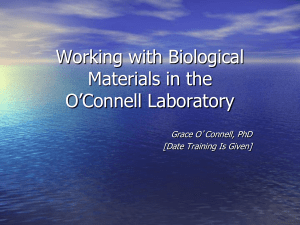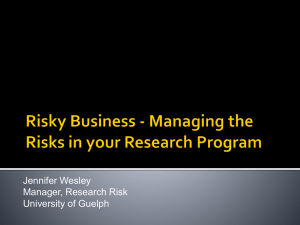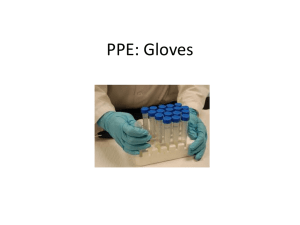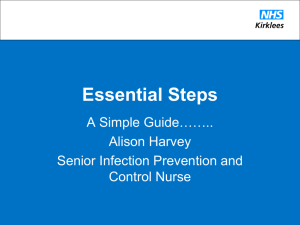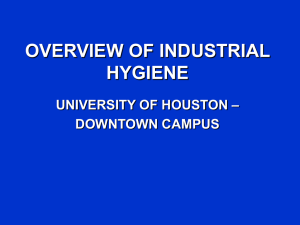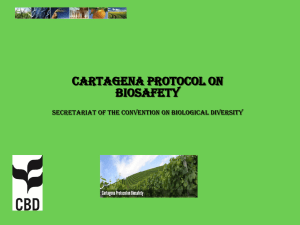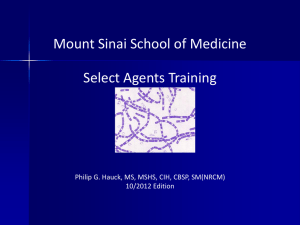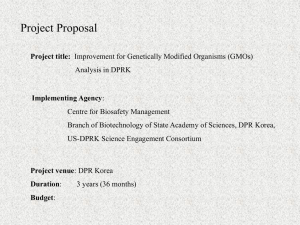Controls in Biosafety II: Work Practices Disinfection & Sterilization
advertisement
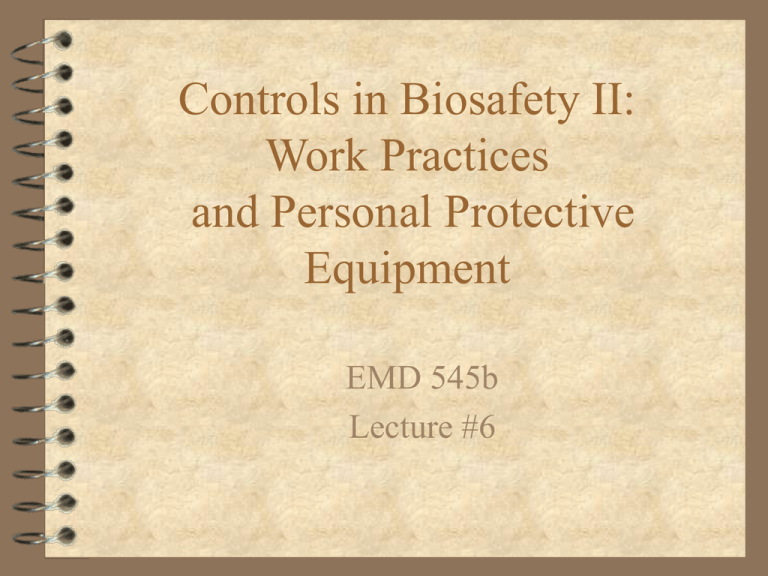
Controls in Biosafety II: Work Practices and Personal Protective Equipment EMD 545b Lecture #6 Biosafety Work Practices Foundation matrix Routes of Exposure on Y axis 7 Basic biosafety work practices on X axis Which practices block each route of exposure? Majority of biosafety work practices stem from the core 7 practices Routes of Exposure Ingestion Inhalation Mucous membranes (eyes, nose, mouth) Percutaneous Biosafety Work Practices No mouth pipetting No eating, drinking, smoking, food storage Wear personal protective equipment Work carefully to avoid creation of aerosols Eliminate/avoid the use of sharps Decontaminate work surfaces/spills Wash hands after removing PPE, skin contact (keep hands away from face) Biosafety Work Practices Administrative – establish safety policies (written SOP) – restrict access to lab to those involved in work – post entry requirements (immunizations, PPE) – labels on equipment storing biohazards, door sign with agent and contact information – ensure training for all who work with hazards – advise all workers of any special hazards – workers must demonstrate proficiency Biosafety Work Practices Transport/Shipping – use two leak proof labeled containers for oncampus shipment (include contact info) – avoid the use of glass primary or secondary containers whenever feasible – Use UN-Approved infectious substance shippers for public roadways, air, other methods of conveyance – All shippers/transporters trained biennially Biosafety Work Practices Contain other aerosol generating procedures – any procedure that imparts energy to a microbial culture, includes: • • • • • • homogenizing, blending, shaking, grinding vortexing, mixing, pipetting, spills opening tubes which are under pressure (vacutainer) removing syringe from vial, expelling air animal bedding, cage dust, animal hair, necropsy droplets from pipets to bench, liquid to liquid (from height), forcibly expelling liquid from pipette Bioafety Work Practices Personnel – ensure reporting of all near misses or incidents – report immunosuppression/compromised skin – evaluate new procedures before initiation – never initiate work without authorization – address all medical requirements before starting – know signs/symptoms of disease, report them – always work carefully, avoid short cuts, follow written SOP’s – keep pets, other unrelated items out of lab Foundational Biosafety Practices Hand washing No mouth pipetting No eating or drinking in lab Minimize aerosol generation Decontaminate work surfaces Safe sharps handling Wear applicable PPE Foundational Biosafety Practice #1 Confine Aerosols Aerosols – Procedures that impart energy into a microbial suspension are a potential source of aerosol (Chatigny, 1974) – Many common lab procedures and accidents have capability of releasing aerosols – homogenization, sonication, blending, mixing, grinding, shaking, vortexing, spills, opening vials, pipetting, animals excreting agent, opening vials under pressure, etc. Confine Aerosols! Promote Awareness of: – Aerosol containment – Work Practices & PPE – Emergency Response Procedures Minimize/prevent lab- acquired infections Aerosols are generated in many procedures Viable Particles Recovered from Air (Chatigny, 1974) Procedure – – – – – – – sonic oscillator mixing w/ pipette overflow from mixer opening lyophilized vial top removed after blending dropping flask of culture dropping lyophilized culture # Particles/ft3 of air – – – – – – – 6 7 9 135 1500 1551 4839 Aerosol spread from open flame Correct Use of Biosafety Cabinets Purge air before and after use Load supplies prior to work Wipe items with disinfectant before loading (or removing) Clean up spills promptly Biosafety Work Practices Effective Use of the Biosafety Cabinet – use to contain aerosols (pipetting, other work) – decontaminate interior before/after use – work at least 4” inside front grille – minimize movement of hands out of cabinet – keep traffic behind operator to a minimum – avoid the use of an open flame inside cabinet Centrifuge Containment Load/unload sealed buckets in a biosafety cabinet Wait 2 to 5 minutes after run to allow aerosols to settle Decontaminate centrifuge and buckets after each use Biosafety Work Practices Centrifugation Precautions – use secondary containment (decon after use) – check tubes for cracks or deformities before use – always use sealed primary tubes – don’t overfill primary containers – balance loads to avoid damage to centrifuge – unit should have solid lid and interlock Confinement at Source Incident Response: Exposures and Spills Emergency Response Aerosol exposure – BL2 • leave lab upon release • Wash wounds, flush face/eyes if exposed, wash hands • post sign, keep area vacated for 20 - 30 minutes to allow aerosols to settle • decontaminate personnel clothing, skin • notify lab supervisor, biosafety, and Health Services if necessary Foundational Biosafety Practice #2 Hand Washing Hand Washing Hands must be washed after removing: – gloves – other PPE – and whenever gloves are damaged or torn Foundational Biosafety Practice #3 No Mouth Pipetting Careful Pipetting Techniques Never blow out last drop in pipette Use pipette aids with filters Horizontal pipette collection tubs Never mix by suction + expulsion Minimize Aerosols Careful pipetting practices Avoid drops onto hard surfaces Wipe up spills promptly with appropriate disinfectant Careful Pipetting Techniques Discharge liquid down side of container Deliver as close as possible to contents Work over plastic-backed absorbent matting Avoid Splatter 1 Incorrect 3 Correct 2 Incorrect Minimize Aerosols Use capped tubes when mixing, blending, or vortexing Pour liquids carefully Avoid bubbles Foundational Biosafety Practice #4 Eliminate or Work Safely with Sharps Use Extreme Care with Sharps Percutaneous exposure risk – Employ safe work practices – Utilize safe sharp devices Aerosol risk – Use biosafety cabinet for removal of air from needle Sharps also includes scalpels, blades and wires. Safe Sharps Devices Only use sharps if absolutely required as part of a process. Ongoing evaluation of new safety devices Safe Use of Sharps Keep hands away from needles. Use mechanical methods for needle removal. Never bend, recap or manipulate sharps by hand. Safe Use of Sharps Disposal/Reprocessing Dispose of entire unit into sharps container. Collect reusable sharps in labeled, leak proof container. Infectious Waste Disposal All cultures and stocks are decontaminated before disposal. Wastes must be in closed containers for transport out of lab. Infectious waste containers must be labeled. Infectious Waste Disposal Written SOP’s for: – Waste management – Regulated sharps – Other sharps (tips, pipettes, glass items, etc.) – Liquid waste Foundational Biosafety Practice #5 No Eating, Drinking or Smoking (Avoid touching your eyes, nose, mouth) Foundational Biosafety Practice #6 Personal Protective Equipment (PPE) Personal Protective Equipment (PPE) Purpose of PPE: • Barrier against skin, mucous membrane or respiratory exposure to infectious agents • To prevent spread of contamination. Laboratory Clothing Protects the worker from splash and splatter during procedures. Protects worker’s clothing from contamination. Can be used to protect product from contamination. Laboratory Clothing: Important Considerations Choice of fabric: must be appropriate for use – Fire retardant and resistant to chemicals – Water repellant if risk of splash and splatter. Can add plastic apron Type and use must be prescribed in SOP or manual and staff trained Laboratory Clothing: Important Considerations Staff must be trained in aseptic removal procedures-gloves last! Reusable clothing must withstand autoclaving Laundry facilities must be provided. Lab clothing not to be taken home. Removing Gloves 1 Removing Gloves 1 2 Removing Gloves 1 2 3 Removing Gloves 1 4 2 3 Gloves: Important Considerations Avoid wetting gloves (disinfectants enhance permeation) Change gloves as soon as feasible after contamination Use utility gloves or double glove for spills Examine utility gloves after washing for integrity Personal Protective Equipment (PPE) Limitations of PPE: • Does not eliminate the hazard. • Integrity wanes with use (change gloves frequently) • Not all gloves created equal - select best glove for the task. Gloves: Important Considerations Latex allergies: Alternatives must be provided Leather, mesh and kevlar used with animal handling (cut, scratch or slice protection) Consider chemical hazards All gloves not created equal Eye and Face Protection Eye and face protection appropriate for the task: Safety glasses - must have side protectors Goggles Face shield and goggles if risk of splash and splatter Respirators Air Purifying Respirator (APR) Uses a filter medium to remove contaminant – Reduces aerosols – Non-powered - masks – Powered - PAPR Assigned Protection Factor – APF = 10 - 50 (NIOSH) for Air Purifying or Powered Air Purifying Respirators Air supplying – Air supplied from safe area – Supplied Air Respirator (SAR) – Air line and + pressure – Self Contained Breathing Apparatus (SCBA) Protection Factor! – APF 10,000 (pressure demand SCBA) Other Considerations Cover exposed skin, dress sensibly Avoid shorts, sandals in the lab Use shoes with non-slip soles Shoe covers for spills or contamination control Rubber boots may be in wet areas needed Foundational Biosafety Practice #7 Decontamination/Disinfection Disinfecting & Cleaning Biosafety Work Practices Disinfection – select appropriate combination of chemical, concentration, and contact time – keep working solutions of disinfectant at bench – use work surface covers (replace frequently) – promptly clean/decontaminate work surfaces & equipment, biohazard waste (and spills) – spot treat reusable protective clothing or launder (never bring home for cleaning) 3 C’s of Disinfection Chemical – Select disinfectant effective against target organism Concentration – Prepare the “referenced” solution Contact time – Disinfectants don’t work instantaneously – EPA uses a 10 minute contact time for testing Disinfectants Disinfectants will destroy or inactivate specific viruses, bacteria, and pathogenic fungi, but not necessarily their spores. Chlorine (household) bleach – 1% dilution for work surfaces – 10% for spills or porous surfaces Disinfectants Alcohol – ethyl alcohol or isopropyl alcohol diluted to 70-85% in water for surface decontamination Other – classified by EPA as tuberculocidal and virucidal – follow manufacturer’s written instructions for use Decontamination Encompasses: – antisepsis, disinfection, decontamination, and sterilization – Antisepsis • chemical applied to living tissue that will control or arrest the growth of a microorganism – Decontamination • disinfection or sterilization of contaminated materials Decontamination Disinfection – To free from infection, reduction of contaminant load to a safe level, does not imply total destruction of all microorganisms. Will not always destroy spores. Sterilization – The destruction of all forms of microbial life. Difficult to achieve (usually referred to a very low chance that a microbe survived). Spill Clean-Up Kit disinfectant paper towels gloves face protection biohazard bags forceps dust pan & brush Personal Protective Equipment Biohazards Personal Protective Equipment (PPE) Protection of: Use: Skin Gloves (double, Clothing Mucous membranes Respiratory system kevlar) lab coats, solid-front gowns, sleeve covers Full-face protection Respirator OSHA Standard 1910.1032 General requirements for PPE, employers must: – conduct hazard assessment, select equipment – inform employees of hazards and equipment selected for protection – provide proper sizes are available – train employees • what PPE, when to wear, how to put on, wear and take off, limitations, care, maintenance, disposal Gloves Latex (allergy) Nitrile vinyl, PVC Polyvinyl Alcohol Neoprene Silver Shield Kevlar Gauntlet Temperature resistant – autoclaves, cryogens Gloves Donning – check before use – size, fit, taping wrists Doffing – remove aseptically – change frequently Double gloving – remove outer pair in contaminated field Dedicate to work area Lab Coats/Gowns Lab coat Back-fastening gown, scrubs Aprons, jump suits (w/ hood, booties) Level A, B, C, D suits Knit grip cuff vs. open cuff, sleeve covers Disposable/Reusable – Treat onsite, use laundry service, no home use – Hook in lab, remove prior to leaving For work in a Biosafety Cabinet solid-front or wrap-around gown gloves (double gloving) face protection (face shield or mask and safety glasses) Face Protection Safety glasses Goggles Face shield Surgical mask/shield Surgical mask/goggles Impact resistant face shield Use of a HEPA-filtered PAPR for additional protection during high-risk research procedures For work outside a Biosafety cabinet solid-front or wrap- around gown or jump suit gloves (double gloving) face protection (face shield or mask and safety glasses) Respiratory protection if aerosols are generated Respiratory Protection Disposable N-95 mask and N- 99/N-100 respirator Powered-Air-Purifying respirator Annual training, medical exam, fit testing Respiratory Protection Disposable Respirators (95%, 99%, 100% efficiencies) – N - not resistant to oil – P - partially resistant to oil – R - resistant to oil Medical questionnaire Annual training Qualitative & quantitative fit testing
